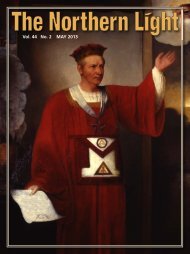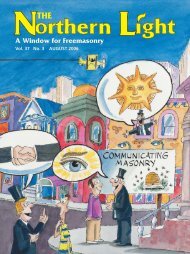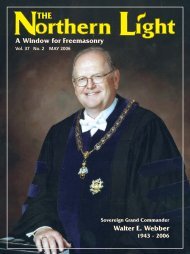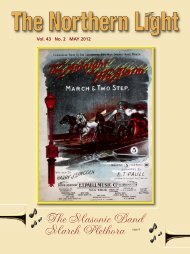The Degree Rituals The Supreme Council, 33 ... - Scottish Rite, NMJ
The Degree Rituals The Supreme Council, 33 ... - Scottish Rite, NMJ
The Degree Rituals The Supreme Council, 33 ... - Scottish Rite, NMJ
You also want an ePaper? Increase the reach of your titles
YUMPU automatically turns print PDFs into web optimized ePapers that Google loves.
<strong>The</strong> <strong>Degree</strong> <strong>Rituals</strong><br />
Several noteworthy examples of radical revision of <strong>Scottish</strong> <strong>Rite</strong> degree<br />
rituals occurred during the first half of the 20th century. In 1922, Frederick<br />
of Prussia and the European setting of the 20° ritual were superseded by<br />
George Washington and the American Revolution. <strong>The</strong> change was believed,<br />
and subsequently proven, to be more effective in communicating the lessons<br />
of patriotism and trustworthiness to an American audience. In 1942, the<br />
drama of the 26° ritual, based on the persecution of early Christians in ancient<br />
Rome, was replaced by the biblical story of Joseph and his brothers which<br />
was seen as an improved medium to communicate the lesson of mercy. That<br />
same year, an elaborate dramatic production set against the colorful background<br />
of Herod’s Temple replaced the time-honored, solemn and didactic ritual<br />
of the 17°, based on the Book of Revelation.<br />
We have touched upon the philosophical justification, if not the imperative,<br />
for ritualistic revision. If the purpose of the ritual is to impart a moral lesson<br />
and shape personal behavior, then it must be meaningful and inspiring to<br />
the individuals to whom it is communicated. This, in turn, requires that the<br />
method in which the ritual is communicated be understandable and that its<br />
content be relevant in the prevailing social culture. Society, as we know, is<br />
subject to continuing change, and during the past 30-odd years that change<br />
has come at an accelerated rate. Of course, truth and the contrast between<br />
moral right and wrong do not change. But means of communication and interpretation<br />
must be responsive to cultural change if the message is to be understood.<br />
9














